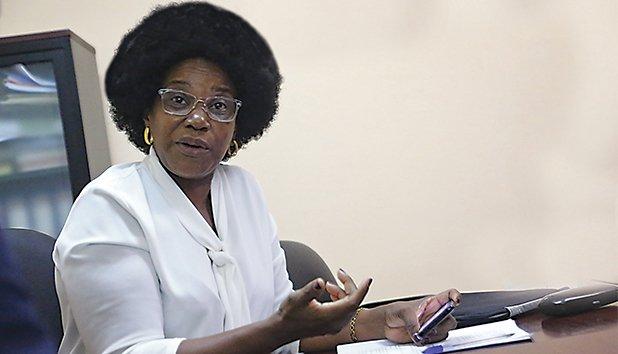Africa-Press – Angola. Jornal de Angola publishes an interview given by geologist Gabriela Pires, focusing on the importance of mapping hydrological risk areas. According to the interviewee, the mapping of these areas helps, in part, to prevent the risks of floods and floods. In Luanda, according to a study cited by the interviewee, among the areas considered susceptible to flooding are the Cidade do Kilamba and the Vida Pacifica and KK-5000 urbanizations. “If a city is not prepared to receive large amounts of precipitation, unwanted effects occur”, warned the geologist.
As a professor at the Faculty of Natural Sciences at Universidade Agostinho Neto, Dr. Gabriela Pires belongs to a Department that has been working on mapping areas of hydrological risk. What link can you make between the results of your investigations and the purposes of World Water Day?
Water is beneficial, but when it comes to precipitation, it has its consequences, which are floods and inundations, especially in urban areas. It is also necessary to take into account the undesirable aspects of the water, caused by the abundant rainfall. The results of the investigations lead me to draw attention to the risks related to rainfall, which are natural, including floods and floods. They (floods) consist of the submersion of an area, which is normally immersed, while flooding is a process that consists of an overflow of the water course in relation to its normal or ordinary bed. The consequences of both are always unpleasant, because they generally produce constraints in populated areas, namely the immobilization and change in the dynamics of people’s lives,
Is it possible to transform an area susceptible to flooding into a housing area?
Rainfalls are natural causes, they exist. They are always welcome in a land that is not inhabited, because the consequences are not felt. There is no risk of loss of life or environmental degradation. The water will follow its normal course. The opposite happens in inhabited areas, be it a town, city, town, village or agricultural field, whose incoming water has impediments to its process. If a city is not prepared to receive large amounts of precipitation, unwanted effects occur. A city that is susceptible to flooding, whose land has characteristics that do not allow water penetration, such as being very flat, with a slope of two percent, and clayey terrain, the susceptibility to flooding is high. Hence it is, from the outset, a risk to transform into a residential area, due to the consequences. But it is possible to build. However, on land of this type, when awarded to be transformed into a housing project, the basic sanitation infrastructure must have the capacity to meet this natural vulnerability to flooding.
Should studies with a view to preparing an area susceptible to flooding be carried out with greater accuracy?
It is essential that environmental impact studies be carried out well in advance, whatever the terrain. These studies include risk, which is done through mapping, which will make it possible to delimit and identify areas in the territory that are susceptible to flooding. And we can use sanitation infrastructure to drain rainwater.
What is the purpose of mapping areas with potential hydrological risks?
Mapping of these areas helps, in part, to prevent the risks of flooding and flooding. There are records of floods laden with debris and sand, in almost the entire area of Baixa de Luanda and Cazenga, due to the rains. If the land already has these susceptibilities, and if there is human occupation (occupation of land areas by man and the resulting exploitation, according to human needs and activities, of natural resources) it is up to us to think about infrastructure for rainwater drainage , to avoid floods, with the capacity to drain, otherwise there will be degradation of the physical space, with ponds, which present themselves as an attack on public health, as they are an environment conducive to the multiplication of mosquitoes. And those floods can be plentiful if we look at climate change situations. That’s why,
Due to the vast experience he carries, resulting from years of research, he is certainly aware of other risk areas, in addition to those mentioned, Baixa de Luanda and Cazenga. Do you feel that, in Angola, there is a concern about the need to have, first, a study of the terrain before the implementation of a housing area?
There are other areas that, very recently, were occupied by the authorities in a directed way and with conceived plans, whose problems should have been addressed. We have the first results of a study carried out in some areas and we can conclude that the area where the Cidade do Kilamba and the KK-5000 were built is problematic, because from the mapping carried out, we concluded that there is susceptibility to self-flooding. From the study carried out, the area where the Vida Pacifica urbanization is located, in Zango, is also among the areas considered susceptible to flooding. In those areas, rainwater drainage equipment can help to solve the problems that occur, but what is seen is regrettable.
Does the existing water drainage equipment in the new urbanizations in the province of Luanda not completely solve the problem?
A team of researchers from various specialties, made up of students and teachers from the Faculty of Natural Sciences, monitored some installation works for this equipment and found that they are placed taking into account the maximum rainfall that can be registered in a day. One of the big problems has to do with the lack of regular and effective maintenance of this equipment. Basic sanitation infrastructure only works efficiently with maintenance. We, geologists who work in land use planning, always take this photograph and present it to the right people. With the information presented in a Geotechnical Cartography, attention is drawn to the risks and dangers of the occupation of a certain area.
“We must be challenged to help propose solutions”
Could the absence of territorial planning and planning be a hydrological risk factor?
No, it is not always associated. We are carrying out a mapping, at the Geology Department of the Faculty of Natural Sciences, and it includes areas susceptible to flooding. Other aspects are also included, such as Lithology (science that studies rocks, including their origin, age, composition, structure and distribution on the planet). Building in Cazenga is not the same as building in Kilamba City, as they are areas that present different lithological situations, due to the intrinsic characteristics of the materials themselves.
What is the reality of Angola or, at least, of the localities that are at the center of investigations by the Department of Teaching and Research (DEI) of Geology of the Faculty of Natural Sciences of the Agostinho Neto University?
The “Geology of Urban Areas” is a project created to carry out cartography, mapping, delimitation, including risk areas, for the production of a Geotechnical Map. There is also the National Geology Plan (PlanaGeo), which includes , among other tasks, the carrying out of geotechnical studies, with the collaboration of the Faculty of Sciences, responsible for the elaboration of the geotechnical maps. PlanaGeo, approved in a resolution, can be extended to the entire Angolan territory, especially in the provinces most affected by several types of risks, including that of flooding, namely Luanda, Bengo, Benguela, Bié, Cuando Cubango, Cunene, Huíla, Cuanza-Norte, Cuanza-Sul, Moxico and Namibe
Which province has the most floods?
The province of Luanda stands out, where the problems are occasional. Next, and more recently, we have Benguela and, sometimes, Cunene, both for floods and droughts, a phenomenon contrary to our approach.
Are the flood risks studied by the researchers from the Faculty of Natural Sciences only those resulting from river floods or, also, from rainwater that falls on urban areas in Angola, most of which are not close to rivers?
In the specific case of Luanda, the floods are caused by precipitation (rain), because the capital does not have a river. In other provinces with a river or crossed by a river, the rain is more an increase in the amount of water. In provinces with probability and history of floods, they (floods) only occur when there is rain.
Can urban development bring with it undesirable effects, extremely harmful to the population, when associated with changes suffered by the hydrological cycle?
The occupation by man is an action that must be done peacefully, because we have to know the land that is occupied, so that the process of cohabitation and the relationship with the environment is peaceful. A non-concerned occupation, in a less conscious way, with disrespect for the characteristics and aptitude of a territory, causes risks, so there must always be a well-designed plan.
Have the results of investigations carried out so far by the Faculty of Natural Sciences of Universidade Agostinho Neto contributed to the creation of policies, strategies and plans for disaster prevention and territorial planning in the management of flood risks?
The model that has been adopted to provide service is not the most appropriate. We have only been informed of the elaboration of works related to our area of expertise by technicians from various institutions, such as local administrations, and we are invited to present contributions. But this collaboration model is not the most correct model for the partnership that needs to be developed in Angola. We must be challenged to go to the field to help propose solutions. We have to be more participants and intervenient in the solution or in the solution proposal, since we are civil society. We want to be integral partners in solving the problems that occur all over the country. We always propose, but…
Has it been difficult to acquire resources and support for research?
Our studies continue to be documentary. But it has been possible to carry out some practical work, resulting from the normal teaching activity, in the interior of the province of Luanda, with the support of the Faculty’s management. However, there are some limitations that prevent us from going to distant areas. We often need to acquire means and support, which has been very difficult.
Are there support difficulties for the work to be done outside the province of Luanda?
There is difficulty in budgeting support for field work. But there is an active co-participation of students. It is important to mention that there are projects financed by the Ministry of Higher Education, Science, Technology and Innovation, through the Science and Technology Development Projects Unit, and by the Development Bank, of the Federal Republic of Germany, whose final works resulted in theses for master’s and doctoral studies carried out at the level of the Southern African Development Community (SADC).
Years ago, a person in charge of the Energy and Water sector stated that the process of monitoring the structural behavior of dams was not the most desirable due to lack of human and financial resources. Should the failure of a dam in Brazil in 2019 be seen by the Angolan authorities as a warning about the need to increase the structural safety of dams?
An accident of this nature is always a learning experience from which we must learn. Perhaps it is necessary to invest in a safety system, which, in addition to monitoring, alerts and prevents such catastrophes, if our dams present vulnerabilities.
Has it been possible to quantify, in academic research, the negative impact on the economy and the environment caused by floods in areas with potential hydrological risks in Angola?
We, at the Faculty of Natural Sciences, do not carry out cost impact studies, with losses and losses. But this task is necessary to quantify the value of the loss. Economists and sociologists have the answers and they are not very encouraging, as there are many losses.
How much does it cost to make and manage a mapping system for hydrological risk areas?
It is relative and complex. Some problems registered in some areas in Angola are not marked on the world map available on the Natural Risk Management website, because the scale is too small.
Is the Geology Teaching and Investigation Department at the Agostinho Neto University’s Faculty of Natural Sciences well served with cutting-edge technology for mapping areas of hydrological risk?
There is a lack of many technological elements capable of helping in the work of mapping risk areas. The need to use state-of-the-art equipment is greater, but for this there must be investment. We need specialized programs and means for the application of techniques that aim to allow the researcher to work more efficiently. But we are not obsessed with the latest equipment. That’s why our investigative work doesn’t stop, because we do science.
For More News And Analysis About Angola Follow Africa-Press






